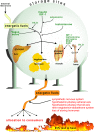Interaction of the endocrine system with inflammation: a function of energy and volume regulation
- PMID: 24524669
- PMCID: PMC3978663
- DOI: 10.1186/ar4484
Interaction of the endocrine system with inflammation: a function of energy and volume regulation
Abstract
During acute systemic infectious disease, precisely regulated release of energy-rich substrates (glucose, free fatty acids, and amino acids) and auxiliary elements such as calcium/phosphorus from storage sites (fat tissue, muscle, liver, and bone) are highly important because these factors are needed by an energy-consuming immune system in a situation with little or no food/water intake (sickness behavior). This positively selected program for short-lived infectious diseases is similarly applied during chronic inflammatory diseases. This review presents the interaction of hormones and inflammation by focusing on energy storage/expenditure and volume regulation. Energy storage hormones are represented by insulin (glucose/lipid storage and growth-related processes), insulin-like growth factor-1 (IGF-1) (muscle and bone growth), androgens (muscle and bone growth), vitamin D (bone growth), and osteocalcin (bone growth, support of insulin, and testosterone). Energy expenditure hormones are represented by cortisol (breakdown of liver glycogen/adipose tissue triglycerides/muscle protein, and gluconeogenesis; water retention), noradrenaline/adrenaline (breakdown of liver glycogen/adipose tissue triglycerides, and gluconeogenesis; water retention), growth hormone (glucogenic, lipolytic; has also growth-related aspects; water retention), thyroid gland hormones (increase metabolic effects of adrenaline/noradrenaline), and angiotensin II (induce insulin resistance and retain water). In chronic inflammatory diseases, a preponderance of energy expenditure pathways is switched on, leading to typical hormonal changes such as insulin/IGF-1 resistance, hypoandrogenemia, hypovitaminosis D, mild hypercortisolemia, and increased activity of the sympathetic nervous system and the renin-angiotensin-aldosterone system. Though necessary during acute inflammation in the context of systemic infection or trauma, these long-standing changes contribute to increased mortality in chronic inflammatory diseases.
Figures



References
-
- Besedovsky HO, Del Rey A. Immune-neuro-endocrine interactions. Endocr Rev. 1996;16:64–102. - PubMed
-
- Turnbull AV, Rivier CL. Regulation of the hypothalamic-pituitary-adrenal axis by cytokines: actions and mechanisms of action. Physiol Rev. 1999;16:1–71. - PubMed
-
- Straub RH, Cutolo M, Buttgereit F, Pongratz G. Energy regulation and neuroendocrine-immune control in chronic inflammatory diseases. J Intern Med. 2010;16:543–560. - PubMed
Publication types
MeSH terms
LinkOut - more resources
Full Text Sources
Other Literature Sources
Miscellaneous

